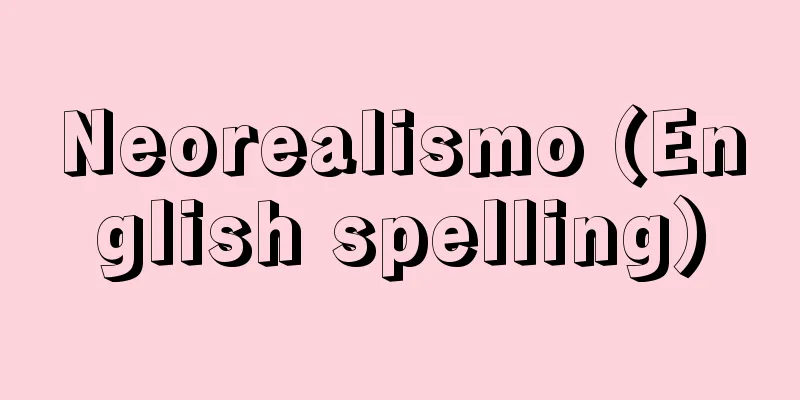Neorealismo (English spelling)

|
A term that indicates the trend and tendency that was dominant in Italian literature and film from the 1940s to the end of the 1950s. Literally, it means "new realism." Neorealism was the artistic expression of the "new reality" of Italy, which had defeated Fascism through the Resistance/War of Liberation, abolished the monarchy, and was reborn as a republic. [Hiroto Koga] literatureIts greatest characteristic was that it viewed works and literary activities in a state of tension with the real world, and sharply questioned the role that literature should play and the responsibilities of writers. It is also important to note that it produced a large number of novels that directly addressed the problems of various regions, particularly the poor southern part of Italy, and that linguistic changes, such as the extensive use of dialects, were also important. In the stifled literary environment under Fascism, the soil for neorealism was the Italian-specific realism of Verga's "verismo," and the vitality of emerging American literature, which Pavese, Vittorini and others worked hard to translate and introduce. Specific works include Pavese's "The Hometown" and Vittorini's "Dialogues in Sicily" (both published in 1941), which are considered to be the forerunners of neorealism, as well as Levi's "Christ Stays at Eboli" (1945), Calvino's "The Path of the Spider's Web" (1947), Pratolini's "The Poor Lovers" (1947) and "Metello" (1955), Yobine's "The Sacramental Land" (1950), and Fenoglio's "23 Days in the City of Alba" (1952), as well as early works by subsequent authors such as Cassola, Bassani, and Pasolini. In terms of poetry, Quasimodo's series of resistance poems, in the magazine Politecnico (1945-1947), and in the series Jettoni (1951-1958) are some of his greatest achievements. Finally, although they are not literary works in the strict sense, the importance of the Letters of the Italian Resistance, a collection of letters left by executed members of the resistance movement, and Gramsci's Prison Notebooks, which evoke the spirit of Italian neorealism, cannot be overemphasized. [Hiroto Koga] movieMeanwhile, a new trend in film emerged in Italy towards the end of World War II and after the war, shocking the world. It was characterized by a camera that stared at reality, and was an innovative technique with strong documentary elements, using amateur actors and shooting on location. Many of the themes were social, and appealed to a strong humanism. Representative works of these early neorealist films include Roberto Rossellini's Open City (1945) and Beyond the Fire (1946), Vittorio De Sica's Shoeshine (1946) and Bicycle Thieves (1948), Luchino Visconti's The Postman Always Rings Twice (1942) and The Earth Trembles (1948), and Pietro Germi's The Law of the Outlaws (1949), with De Sica's Umberto D (1952) being a prescient work about the worsening problem of the elderly. Screenwriter and theorist Cesare Zavattini (1902-1989) also played an important role, and Michelangelo Antonioni and Federico Fellini were among the artists who grew up here. Ingrid Bergman, a major Hollywood star at the time, ran to Rossellini and starred in Stromboli (1950). These Neorealism films also impressed Japanese critics and audiences, who were also from a defeated country, and discussions of "realism" became lively in the forum. Meanwhile, in France, film critic André Bazin highly praised Neorealism, and it had a major influence on the younger generation, including the French New Wave. [Kenji Iwamoto] "Italian Films - Their Neo-Realism" by Taihei Imamura (1953, Hayakawa Publishing) " What is Film? III: Aesthetics of Reality, Neo-Realism" by Andre Bazin, translated by Eiji Koumi (1973, Bijutsu Shuppansha) "Reading Italian Films" by Kazuhiro Yanagisawa (2001, Film Art Publishing) [References] | | | | | | | | | | | | | | | | | |Fenoglio| | | | | | | |Source: Shogakukan Encyclopedia Nipponica About Encyclopedia Nipponica Information | Legend |
|
1940年代から1950年代末にかけてイタリア文学・映画において支配的であった潮流、傾向を示すことば。字義的には「新しいリアリズム」の意。レジスタンス=解放戦争によってファシズムを倒し、君主制を廃止して共和国として生まれ変わったイタリアの「新しい現実」の芸術的表現がネオレアリズモであった。 [古賀弘人] 文学作品、文学活動を現実の社会との緊張関係においてとらえ、文学の果たすべき役割、作家の負う責務を鋭く問うたことが最大の特徴であった。各地方、とりわけ、貧しい南部イタリアの問題を真正面から取り上げた小説が数多く生まれたこと、方言の多用といった言語面の変革も見逃すことはできない。ファシズム下の窒息した文学状況にあってネオレアリズモの土壌となったのは、イタリア固有のリアリズムであったベルガの「ベリズモ」と、パベーゼやビットリーニらが翻訳、紹介に力を尽くした新興のアメリカ文学の活力であった。 具体的な作品としては、ネオレアリズモの先駆と目されるパベーゼの『故郷』とビットリーニの『シチリアでの対話』(ともに1941年刊)のほか、レービの『キリストはエボリにとどまりぬ』(1945)、カルビーノ『蜘蛛(くも)の巣の小道』(1947)、プラトリーニ『貧しい恋人たち』(1947)、『メテッロ』(1955)、ヨービネ『秘蹟(ひせき)の地』(1950)、フェノッリオ『アルバ市の23日間』(1952)などがあり、後続のカッソーラ、バッサーニ、パゾリーニらの初期作品も含まれる。詩ではクアジーモドの一連の抵抗詩、雑誌では『ポリテクニコ』(1945~1947)、叢書(そうしょ)では「ジェットーニ」叢書(1951~1958)の功績が大であり、最後に、狭義の文学作品ではないが、イタリア・ネオレアリズモの精神のありかを喚起するものとして、抵抗運動の刑死者の残した書簡を集めた『イタリア抵抗運動の遺書』とグラムシの『獄中ノート』の重要性はいかに強調してもしすぎることはない。 [古賀弘人] 映画一方、第二次世界大戦末期から大戦後にかけてイタリアに新しい傾向の映画が生まれ、世界各国に新鮮な衝撃を与えた。現実を凝視するカメラが特長となっており、素人俳優の採用やロケーション撮影によるドキュメンタリー的要素が強い画期的な手法で、テーマは社会的なものが多く、強いヒューマニズムで訴えた。これら初期のネオレアリズモ映画の代表的作品に、ロベルト・ロッセリーニの『無防備都市』(1945)、『戦火のかなた』(1946)、ビットリオ・デ・シーカの『靴みがき』(1946)、『自転車泥棒』(1948)、ルキーノ・ビスコンティの『郵便配達は二度ベルを鳴らす』(1942)、『揺れる大地』(1948)、ピエトロ・ジェルミの『無法者の掟(おきて)』(1949)などがあり、デ・シーカの『ウンベルトD』(1952)は、深刻化する老人問題の予見的作品。脚本家で理論家のチェーザレ・ザバッティーニCesare Zavattini(1902―1989)も重要な役割を果たし、ミケランジェロ・アントニオーニ、フェデリコ・フェリーニらもここから育っていった。当時、ハリウッドの大スターであったイングリッド・バーグマンはロッセリーニのもとへ走り『ストロンボリ』(1950)に主演。これらネオレアリズモの映画は、同じ敗戦国の日本人批評家や観客へも感銘を与えて、論壇では「リアリズム」をめぐる議論が活発化した。一方、フランスでは映画批評家アンドレ・バザンがネオレアリズモを高く評価して、ヌーベル・バーグら若い世代に大きな影響を与えた。 [岩本憲児] 『今村太平著『イタリア映画――そのネオ・リアリズム』(1953・早川書房)』▽『アンドレ・バザン著、小海永二訳『映画とは何かⅢ 現実の美学・ネオ=リアリズム』(1973・美術出版社)』▽『柳澤一博著『イタリア映画を読む』(2001・フィルムアート社)』 [参照項目] | | | | | | | | | | | | | | | | | | | | | | | | | |出典 小学館 日本大百科全書(ニッポニカ)日本大百科全書(ニッポニカ)について 情報 | 凡例 |
Recommend
Kingchi (English name) Pseudosciaena manchurica
A marine fish of the family Sciaenidae in the orde...
Samain - Saman (English spelling) Albert Samain
A French Symbolist poet hailed as the "poet ...
Cherry blossoms
A historical work. 3 volumes. The author is unknow...
Qinā (English spelling) Qina
...the capital of the Egyptian province of the sa...
Hanasanjin - Hanasanjin
A comic writer in the late Edo period. He was als...
Cypris larva - Cypris fairy
...The ovaries are located on the stalk, and the ...
Nicholson, W. (Painter) (English spelling) NicholsonW
...After these artists, Helen Bannerman (1863-194...
Relative Trade Law - Aitaibouekiho
Trading methods for Nagasaki trade from 1655 to 16...
Silk wholesaler - Kinutoya
…For a time, they also bought silk directly from ...
Naja haje (English spelling)
… [Takahiro Matsui]. … *Some of the terminology e...
Brushing your teeth - Toothpaste
This refers to the cleaning action of the mouth an...
Pozarevac (English spelling)
…the treaty of peace between the Ottoman Empire a...
book system
…For this purpose, a certain format and proofread...
Grammitidaceae
...It was named after Okubo Saburo, an assistant ...
Carrot and stick - Carrot and stick (English spelling) mit Zuckerbrot und Peitsche
A political strategy. The carrot means to win the ...





![Sagara [town] - Sagara](/upload/images/67cba856b3741.webp)



